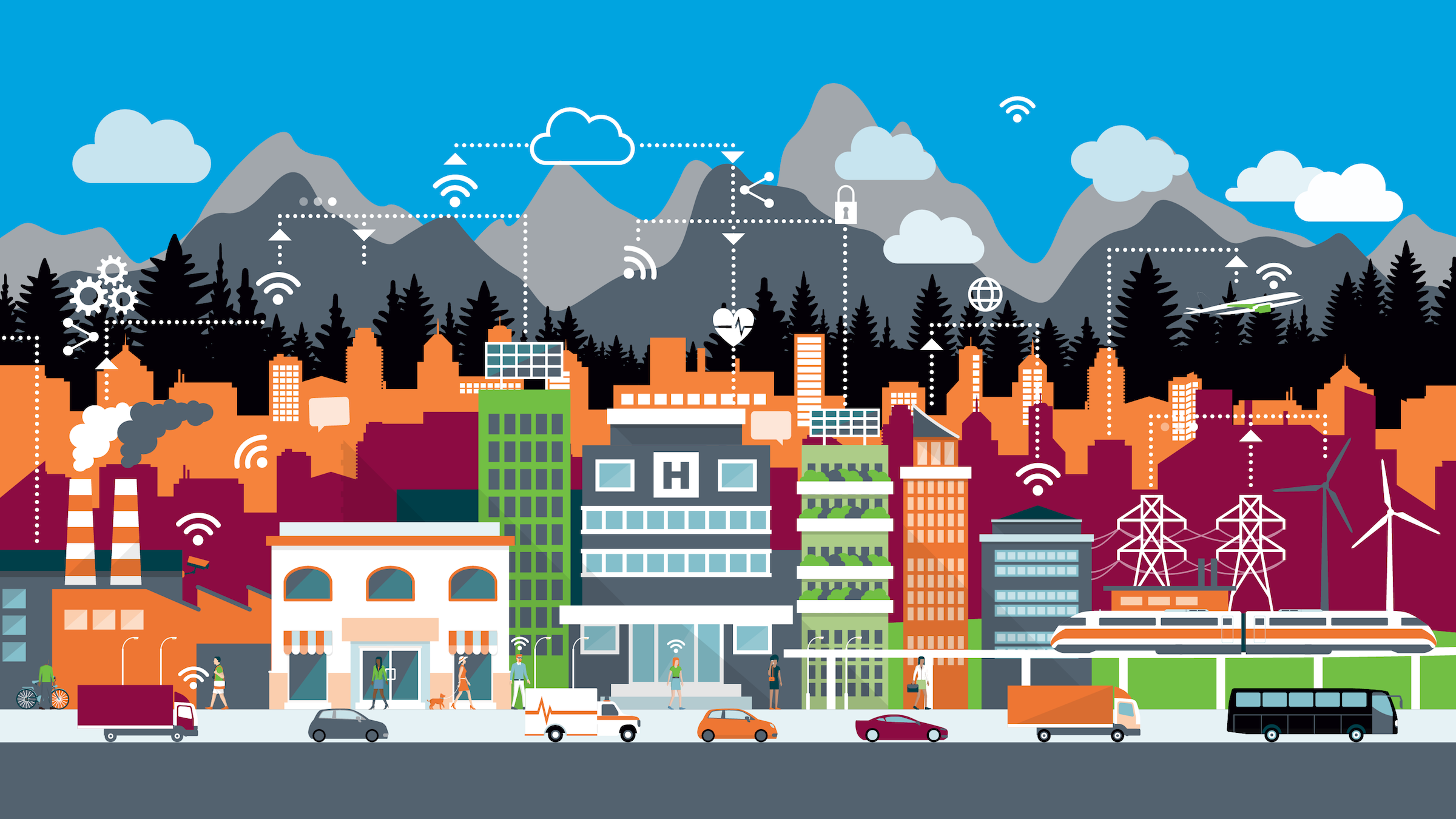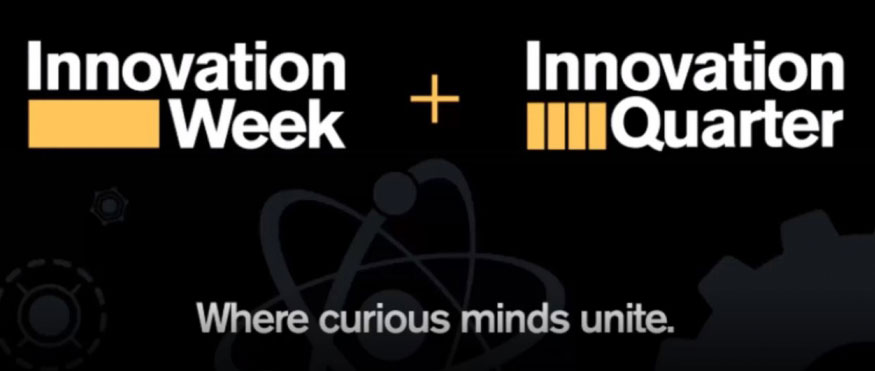Design experience challenges students to imagine pandemic-resistant smart cities

ASU students worked with university and industry mentors in a technology and product design challenge to explore ways future smart cities could respond to threats like COVID-19. Image by Tumisu from Pixabay
Few times in history have seen a more dire need to find solutions to a global societal crisis than the present.
The COVID-19 pandemic has dramatically raised a challenge to fast-track discovery and implement innovations to avert further tragic consequences of the disease, said Anthony Kuhn, a lecturer in the Ira A. Fulton Schools of Engineering at Arizona State University.
Kuhn and industry professionals with Infosys, a global leader in next-generation digital services and consulting, recently facilitated an ASU Innovation Week/Innovation Quarter engineering, technology and product design experience. Called "Reimagine Smart Cities in a post-COVID World," the event offered ASU students an opportunity to step up to a demanding test of their ingenuity.
The five-day endeavor, conducted virtually from Jan. 4–8, tasked students with formulating and pitching ideas for employing high-tech devices and systems to enable urban centers to better protect people from threats of pandemics.
In an opening address, Infosys Vice President of Sustainability and Design Consulting Corey Glickman told students that more than half the world’s population will be living in cities within the foreseeable future. That could set the stage for future COVID-19-like dangers, he said, unless we can develop better tools and resources to provide densely populated metropolitan regions the means and methods to effectively respond to and halt budding potential pandemics.
Students were directed to focus on ideas for ways to integrate pandemic-resistant practices into the operations of health care systems, the design and construction of public infrastructure systems and other built environments, and transportation systems and services.
Embracing the entrepreneurial mindset
To guide their efforts to fulfill the design objectives, students consulted with mentors from ASU and companies recognized as global leaders in technological innovation — including Infosys, Amazon, Microsoft and Starbucks.
Kuhn, Glickman and other mentors advised students that the most critical goal was to demonstrate that their proposed solutions would be both technically and financially feasible, and address user experience factors such as adaptability and desirability.
Students were also given lessons by Kuhn and Cheryl Heller on key elements of design processes that companies use to formulate ideas for moonshot projects. Heller is a director of design innovation and a professor of practice in ASU’s Herberger Institute for Design and the Arts, W. P. Carey School of Business and the Fulton Schools.
Students had to be prepared to give the event’s judges answers to many related questions: Could the proposed tech solution be efficiently scaled up and deployed to meet the needs of sizable populations? Is the solution unique or an adaptation of existing technology? Does the business model show convincingly how the venture will benefit users, investors and other stakeholders?
They also had to be ready to address any potentially problematic social implications of the development and use of new technologies, along with queries about how their venture would confront possible challenges from competitors in the marketplace.
“It’s all about adopting the entrepreneurial mindset when you prepare your business pitch,” Kuhn said. “That helps you clarify your message when you have to boil down complex technological concepts into simple and compelling ideas.”
The students “showed true dedication to their work. They went from ideation to prototyping in just five days, while also balancing obligations of full-time jobs and families,” Kuhn said.
Smart cities utilize advanced information, communications and sensor technology to monitor and manage public infrastructure and related resources. By integrating the technologies with Internet of Things networks, cities are optimizing operations of water and power utilities, waste management, emergency response agencies and other community services. The increasingly proficient systems might be used in the future to mount defenses against the threat of pandemics like COVID-19. Graphic: Rhonda Hitchcock-Mast/ASU
Proposed solutions display creativity and technical know-how
Nine students made it to the final stage of the event, in which they made their pitches to the panel of judges.
Ainee Ali, a graduate student in the learning design and technology program in ASU’s Mary Lou Fulton Teachers College, is developing a solar-powered, self-charging mobile device. Called SolarWind, the technology is designed to be especially helpful to students in developing countries where electrical power services and communications systems can be unreliable.
The device would benefit low-income students who can’t afford personal computers or laptops by providing the alternative of using cell phones, which are often less expensive than computers. It could also help students keep their cell phones charged so their lessons would not be interrupted by lapses in internet connectivity that hinder online learning.
Along with being solar-powered, SolarWind has technologies such as a 5G built-in mini-cellular tower and a smart screen that uses an age-detecting algorithm.
Fulton Schools electrical engineering undergraduate student Paris Poor’s project explored helping people protect their health in public spaces by using aerosolized nanorobots.
Poor says nanobot technology now being created and tested for use in medical and environmental fields shows promise for being capable of detecting, identifying, locating and eliminating airborne contaminants — which would include cleaning particles of the coronavirus that causes COVID-19 out of the air. She hopes to contribute to research in that area.
Tina Sindwani, a first-year Fulton Schools computer systems engineering student, pitched her idea for keeping communities informed about public health emergencies and advising actions people can take to protect their health.
Sindwani proposed establishing interactive communication hubs to provide information to increase pandemic preparedness — including kiosks enabling downloading of information to people’s portable and wearable devices.
The first two steps of her five-step Public Health Awareness Plan are already in early stages of implementation on existing interactive kiosks near the ASU campus in downtown Tempe, Arizona.
Christopher Carpentier, an MBA student in the W. P. Carey School of Business, and Fulton Schools human systems engineering undergraduate student Margaret Wong teamed up to develop an idea for a crowdsourced micro mobility engagement platform at ASU.
The project involves the university providing smart bicycle lights through the local bike registration system. These thousands of bike lights would not only provide safety, but could be used to collect environmental data through Internet of Things sensors.
The data would then go to the cloud so students could analyze it in classes, workshops and hackathons, and then use the data as a basis for recommendations to protect the community’s health by making the campus area’s mobility infrastructure safer.
Reece Piper, a graduate student in the innovation and venture development program in the Herberger Institute, came up with a project called BarrAIRcade, a table-top air curtain designed to replace plexiglass dividers at indoor tables in public places.
The system employs streams of air as a barrier to prevent the spread of COVID-19 through aerosolized droplets — without impeding sound, movement or sight, unlike most current plexiglass solutions. The system is self-cleaning and incorporates viral air monitors.
Ginger Doran, a graduate student in ASU’s Watts College of Public Service and Community Solutions, focused on using noise cancellation technology to create quieter spaces in homes. That would enable people using telehealth services to maintain their privacy when communicating with health care providers even when they are not alone in their residences.
Julianna Jara, who is in her final year as a business sustainability student in the W. P. Carey School of Business, is at work on Jara Java, an idea for a venture focused on “connecting communities through coffee.” The connection would be made through a data collection app that will provide users reward-based recycling opportunities.
The bigger goal is for the social media platform to also foster “transparency between communities, businesses and government” that will generate insights about “what citizens need and want,” and thus provide guidance for developing smart cities in ways that best serve people, Jara says.
The design experience event judges gave Ali and Poor the top prizes, the Best Moonshot Solutions awards. Sindwani and the team of Carpentier and Wong received the Best Near-Future Solution awards. The awards came with a prize of $500 for each winning project in the form of “book scholarships” students can use to purchase books and related resources for their academic studies.
The "Reimagine Smart Cities in a post-COVID World" design challenge was part of ASU’s Innovation Quarter program (preceded by Innovation Week events). Innovation Quarter provided activities and educational sessions to help students explore new ideas, enhance their academic achievements, learn career development skills, build connections with peers and industry leaders, and engage effectively within their professional communities. Graphic: Connor McKee/ASU
Showcasing students’ range of high-demand skills
Glickman says all of the participants “were very impressive in the ways they worked to create solutions that were both innovative and practical from the viewpoint of good design, technical feasibility and business viability, all in just a week of intensive activity.”
Each student who participated earned LinkedIn Digital Badges, a credential intended to validate individuals’ skills and their achievements in learning programs or activities such as the Smart Cities design experience.
More importantly, students had opportunities “to develop their toolbox of technical skills that are in demand by top employers,” said Robin Hammond, director of the Fulton Schools of Engineering Career Center. “By co-sponsoring programs like this, we can take an active role in facilitating and supporting students on their journey to be day-one career ready.”
The center assisted with planning and advertising the event, recruiting industry partners and the keynote speaker (Glickman), and negotiated exclusive access to Wingspan, a collaboration and skills-building platform, which enabled the ASU event. All participants were provided access to Wingspan as a learning reference. The career center also planned and organized a networking session with industry partners and Innovation Quarter participants and donated $2,000 for book scholarships.
The event was a prime example of university-industry partnerships that “help to bridge the gap between education, research and the workforce,” said Grace O’Sullivan, vice president of Corporate Engagement and Strategic Partnerships within ASU Knowledge Enterprise.
“These partnerships not only provide students opportunities such as internships and job placement after graduation but also enhance their educational experience with opportunities such as pipeline programs and applied research projects,” O’Sullivan said. “Infosys is a strategic partner for ASU and this engagement offers a first look at innovative research and access to our diverse talent pool.”
“Infosys has always been a promoter of providing students with real-life experience to drive their success. This unique university-industry partnership is a significant step toward that goal,” said Sambit Mohanty, head of education for Infosys in North America.
“As comprehensive strategic partners, Infosys and ASU are committed to collaborating over a broad spectrum of high value engagements,” Mohanty said, noting that the growing partnership involves thought leadership, talent development, educational attainment, experiential learning and commercial implementation.
The event was supported in part through the ASU Kern Project, funded by the Kern Family Foundation. The ASU Kern Grant promotes faculty and staff partnering to provide engineering leadership through the Kern Entrepreneurial Engineering Network, or KEEN, which strives to integrate the entrepreneurial mindset into engineering education.
More Science and technology

The Dreamscape effect
Written by Bret HovellSeventh grader Samuel Granado is a well-spoken and bright student at Villa de Paz Elementary School in…

Research expenditures ranking underscores ASU’s dramatic growth in high-impact science
Arizona State University has surpassed $1 billion in annual research funding for the first time, placing the university among the…

Programming to predict the unpredictable
As the natural world rapidly changes, humanity relies on having reliable, accurate predictions of its behavior to minimize…

